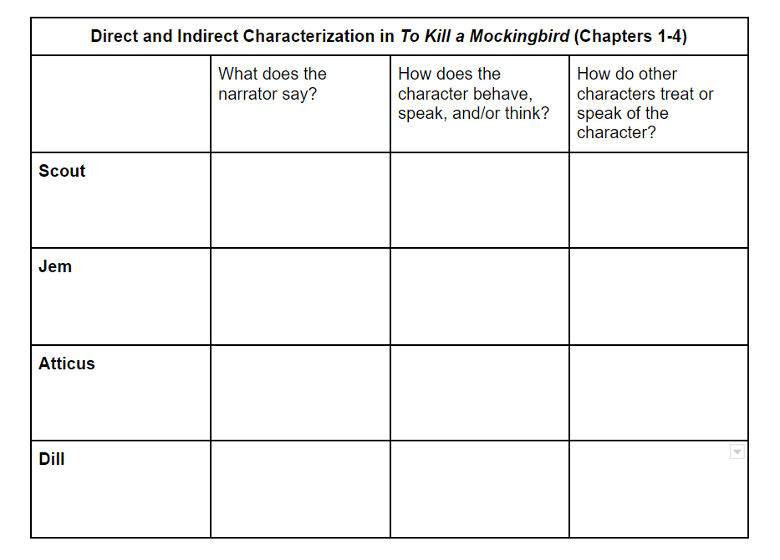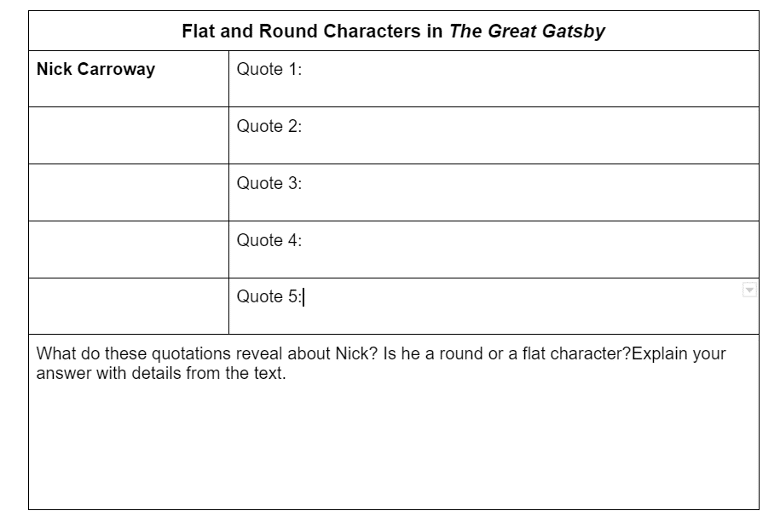Character Development in Literature
Without characters there would be no plot and no conflicts. Readers should take note of the author’s methods of character development, the characters’ traits and actions, and how the characters change (or don’t change) over the course of the story.
Direct and Indirect Characterization
Character development is a matter of show and tell. Writers can tell the audience directly about a character’s traits by using direct characterization or show the audience what the character is like by using indirect characterization.
Direct Characterization
Direct characterization occurs when the narrator of a novel or story directly describes a character’s traits or personality. For instance, in the famous short story “The Open Window,” Saki describes one of the main characters, Vera, as “a very self-possessed young lady of fifteen.” With direct characterization, the audience is told about the character in a straight-forward way that requires no guesswork from the audience.
Indirect Characterization
Indirect characterization requires the readers to make inferences about a character based on his or her behavior as well as his or her interactions with other characters. When analyzing indirect characterization, the reader should especially pay attention to:
● what the character does
● what the character says and/or thinks
● how other characters treat the character you’re analyzing
● what other characters say or think about the character you’re analyzing
For example, in To Kill a Mockingbird, Harper Lee uses indirect characterization to emphasize Mrs. Dubose’s grumpiness toward the Finch children. According to the child narrator, Scout, “We could do nothing to please her. If I said as sunnily as I could, ‘Hey, Mrs. Dubose,’ I would receive for an answer: ‘Don’t you say hey to me, you ugly girl! You say good afternoon, Mrs. Dubose!’ ” The audience can interpret this exchange to determine that Mrs. Dubose is a cantankerous woman who doesn’t seem to like children.
Flat and Round Characters
Another way to classify characters has to do with the depth of their characterization.
Flat Characters
Flat characters are fairly predictable and lack complexity. Most flat characters exhibit only one or two main personality traits and often serve the purpose of moving the plot along.
For instance, in F. Scott Fitzgerald’s The Great Gatsby, Daisy Buchanan’s character could be labeled as flat. The novel emphasizes that her main motivation in life is the pursuit of material wealth. When Daisy is questioning whether she should marry Tom, she receives an extravagant pearl necklace from him. The expensive gift sways her decision, and she decides to go through with the marriage because of the luxurious lifestyle that Tom can provide for her.
Round Characters
Round characters, on the other hand, are nuanced and complex, more like real people. Their depth and authenticity contribute to the plot and add to the sense of engagement the audience feels.
Atticus Finch, Scout’s father in To Kill a Mockingbird, is a good example of a round character. Over the course of the novel, the reader learns that Atticus is a loving and gentle father and a social justice warrior who isn’t afraid to stand up for a Black man in a racist society. Atticus is a multifaceted character who chose to diverge from the family tradition of growing cotton in favor of a law career. In Chapter 11, when a rabid dog is on the loose, Atticus surprises his children by demonstrating his skills as an excellent marksman and taking down the dog in one shot. Atticus is a round character because his character is complex and well-defined.
Static and Dynamic Characters
Yet another method to classify characters involves examining how the character changes (or doesn’t change) as the story unfolds.
Static Characters
Static characters don’t change much over the course of the story or novel. Their characteristics remain mostly the same from the beginning to the end of the work of literature. Atticus Finch, though he is a round character with many well-developed traits, is also a static character. His strong sense of morality and love for his children and community are unchanged despite the tribulations he and his family encounter over the course of To Kill a Mockingbird.
Dynamic Characters
Dynamic characters are defined by the change or evolution they undergo during the story. These changes are usually sparked by the dynamic character’s experiences as he or she responds to conflicts. Though Atticus remains basically unchanged by the events that unfold in Maycomb, his daughter, Scout, grows and changes as she learns more about human nature and the injustice faced by Black people in her community. In the final scene, as she walks her mysterious neighbor home, the audience realizes that Scout’s capacity for empathy has expanded immensely since the beginning of the book. She has grown into a mature young lady with a much greater understanding of the world and the people around her.
Teaching Character Development
Teaching character development does not have to be a complicated process. You can start by having your students choose a few characters introduced in the first chapters of a novel. Students may use a graphic organizer similar to the one below to write down their initial impressions of the characters by recording the character traits revealed through both direct and indirect characterization.
As the novel progresses into the middle chapters, your students can continue tracking the characters and begin to analyze whether the characters are showing signs of being round or flat characters. A good way to do this is by pulling several quotations spoken by the character or about the character. Students can then examine the quotes to see if they portray a nuanced and multifaceted character or if they reveal mostly the same character traits over and over again. If you have more than one student reading the same book, you can have them choose different characters and then discuss their observations and analysis.
In the final chapters, your students will be able to determine if the characters are static or dynamic by closely interpreting their words and actions as the final conflicts are resolved. This type of analysis works well for an end-of-novel essay.
If you’re looking for a hassle-free homeschool literature curriculum, consider Essentials in Literature. With a focus on exploring and analyzing literary elements through short stories, short works of nonfiction, novels, and poetry, Essentials in Literature features engaging video lessons and meaningful analysis assignments delivered in bite-sized chunks that make for a low-stress experience for both the homeschool student and teacher.






